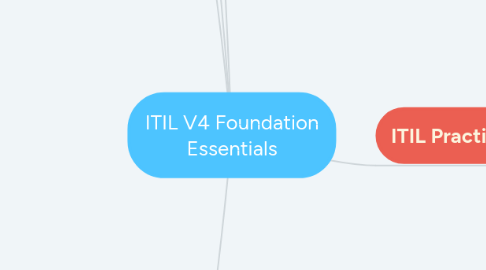
1. Why?
1.1. the world is
1.1.1. Dynamic, fast
1.1.2. Volatility
1.1.3. Uncertainty
1.1.4. Complexity
1.1.5. Ambiguity
1.2. to optimize value
1.3. Digital transformation
1.3.1. Key tech
1.3.1.1. Social media
1.3.1.2. Cloud computing
1.3.1.3. Big data
1.3.1.4. IOT
1.3.1.5. Cyber security
1.3.1.6. Mobility
2. Roadmap
2.1. Foundation
2.2. Specialist / Strategist
2.3. Managing Professional / Strategic Leader
2.4. Master
3. Warranty: how service performs, fitness for use
4. Key concepts
4.1. Creating value
4.1.1. Output: tangible or intangible deliverable
4.1.2. Outcome: Result for stakeholder produced by outputs
4.1.3. Cost VS Risk: Imposed or Removed from consumer
4.1.4. Co-creation: within & between organizations
4.1.4.1. Organization
4.1.4.2. Service Management
4.1.4.3. Service: Means of enabling value co-creation by facilitating outcomes without customer managing cost and risk
4.1.4.4. Value: Perceived benefits, important, useful
4.1.5. Stakeholders
4.1.5.1. Customer: defines requirement and responsible for outcome of service consumption
4.1.5.2. Sponsor
4.1.5.3. User
4.2. Product and Service
4.2.1. Product: configuration of resources
4.2.2. Service: based on one or more products
4.2.3. Service offering
4.2.3.1. Goods
4.2.3.2. Access to resources
4.2.3.3. Service actions
4.3. Service Relationships
4.3.1. Service provider
4.3.1.1. Perceived service value
4.3.1.2. Consumer risk levels
4.3.2. Utility & Warranty
4.3.2.1. Utility: what service does, fit for purpose
4.4. Service value
4.4.1. Guiding Principles
4.4.1.1. Focus on value
4.4.1.2. Start where you are
4.4.1.3. Progress iteratively
4.4.1.4. Collaborate and promote visibility
4.4.1.5. Think and work holistically
4.4.1.6. Keep simple and practical
4.4.1.7. Optimise and automate
4.4.2. 4 Dimensions of Service Management
4.4.2.1. Organization and People
4.4.2.2. Information and Tech
4.4.2.3. Partners and Suppliers
4.4.2.4. Value Streams and Processes
4.4.3. Service Value System
4.4.3.1. Guiding Principles
4.4.3.2. Governance
4.4.3.3. Service Value Chain
4.4.3.3.1. Plan
4.4.3.3.2. Eagage
4.4.3.3.3. Design & Transition
4.4.3.3.4. Obtain/ build
4.4.3.3.5. Deliver & support
4.4.3.3.6. Improve
4.4.3.4. Practices
4.4.3.5. Continual Improvement
5. ITIL Practices
5.1. Understand 7 practices
5.1.1. Continual improvement
5.1.1.1. Align organisational practices and services with changing biz needs
5.1.1.2. Full time improvement group
5.1.1.3. Continual Imp Register CIR
5.1.2. Change control
5.1.2.1. Maximize successful IT changes
5.1.2.2. Types of changes
5.1.2.2.1. standard
5.1.2.2.2. normal
5.1.2.2.3. emergency
5.1.2.3. Ensure correct change authority assigned to each type
5.1.3. Incident management
5.1.3.1. Minimize negative impact of incidents
5.1.3.2. Allocate & manage resource based on priority
5.1.3.2.1. Direct incident to correct support area
5.1.3.3. Requires knowledge & consideration of biz impact
5.1.3.4. Root cause analysis is NOT in this scope
5.1.4. Problem management
5.1.4.1. Reduce likelihood and impact of incidents
5.1.4.2. Manage workarounds & known errors
5.1.4.3. Phases: Problem identification -> Problem control -> Error control
5.1.5. Service request management
5.1.5.1. Support agreed quality of service
5.1.5.2. Handle pre-defined, user initiated requests
5.1.5.2.1. May include change to service or component
5.1.5.2.2. Submitted by user or user rep
5.1.5.2.3. As standard change
5.1.6. Sevice desk management
5.1.6.1. Capture demand for incident resolution & service request
5.1.6.2. Ensure access channels, clear communication path for users
5.1.6.3. Classify User request
5.1.6.3.1. Acknowledged
5.1.6.3.2. Classified
5.1.6.3.3. Owned
5.1.6.3.4. Actioned
5.1.7. Service level management
5.1.7.1. Set clear biz based target
5.2. Know purpose and key terms of another 8 practices
5.2.1. Information security management
5.2.1.1. CIA
5.2.1.2. Authenticaton
5.2.1.3. Non-repuduation
5.2.2. Relationship management
5.2.2.1. establish and nurture links between org & its stakeholders
5.2.3. Supplier management
5.2.3.1. ensure org suppliers and their performance appropriately managed
5.2.4. IT asset management
5.2.4.1. Plan & manage full lifecycle of IT assets
5.2.5. Monitoring and event management
5.2.5.1. Systematically observe services
5.2.6. Release management
5.2.6.1. Make new or changed service & feature available for use
5.2.7. Deployment management
5.2.7.1. Move ....to live environments
5.2.8. Service configuration management
5.2.8.1. Ensure accurate & reliable info about config of sevices
5.2.9. Service continuity management
5.2.9.1. ensure service at sufficient level in disaster
5.2.10. Availability management
5.2.10.1. ensure service deliver agreed levels
5.3. Terms
5.3.1. IT asset
5.3.1.1. Any valuable component that can contribute fo deliver IT product or service
5.3.2. Event
5.3.2.1. Any change of state that has significance for management of CI
5.3.3. Configuration item
5.3.3.1. Any component that needs to be managed in order to deliver IT service
5.3.4. Change
5.3.4.1. Addition, modification or removal of anything that could have direct or indirect effect on services
5.3.5. Incident
5.3.5.1. Unplanned interruption to service or reduction in quality of service
5.3.6. Problem
5.3.6.1. A cause, or potential cause, of incident
5.3.7. Known error
5.3.7.1. A problem that have been analysed but not resolved
